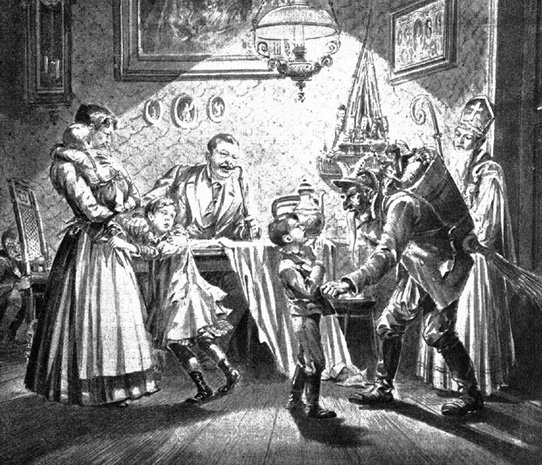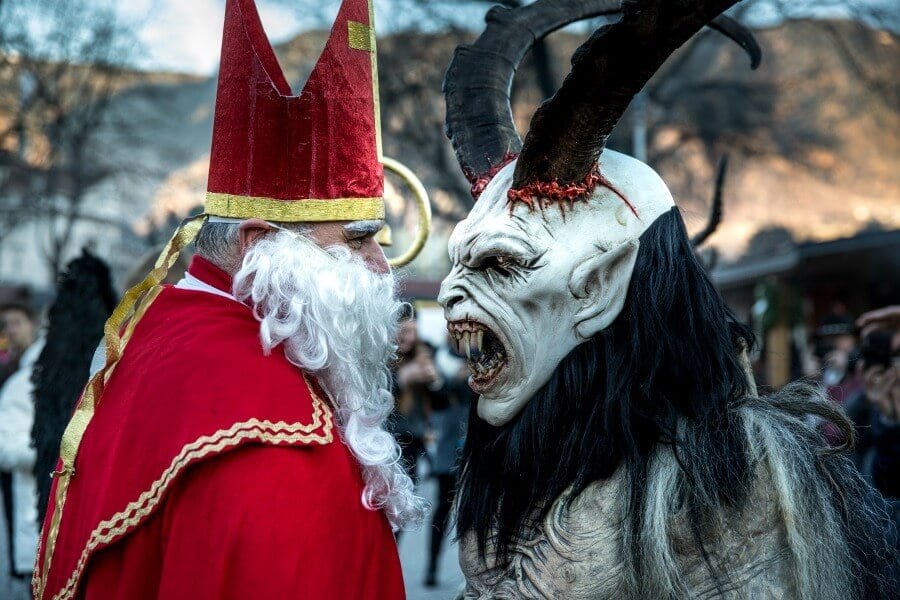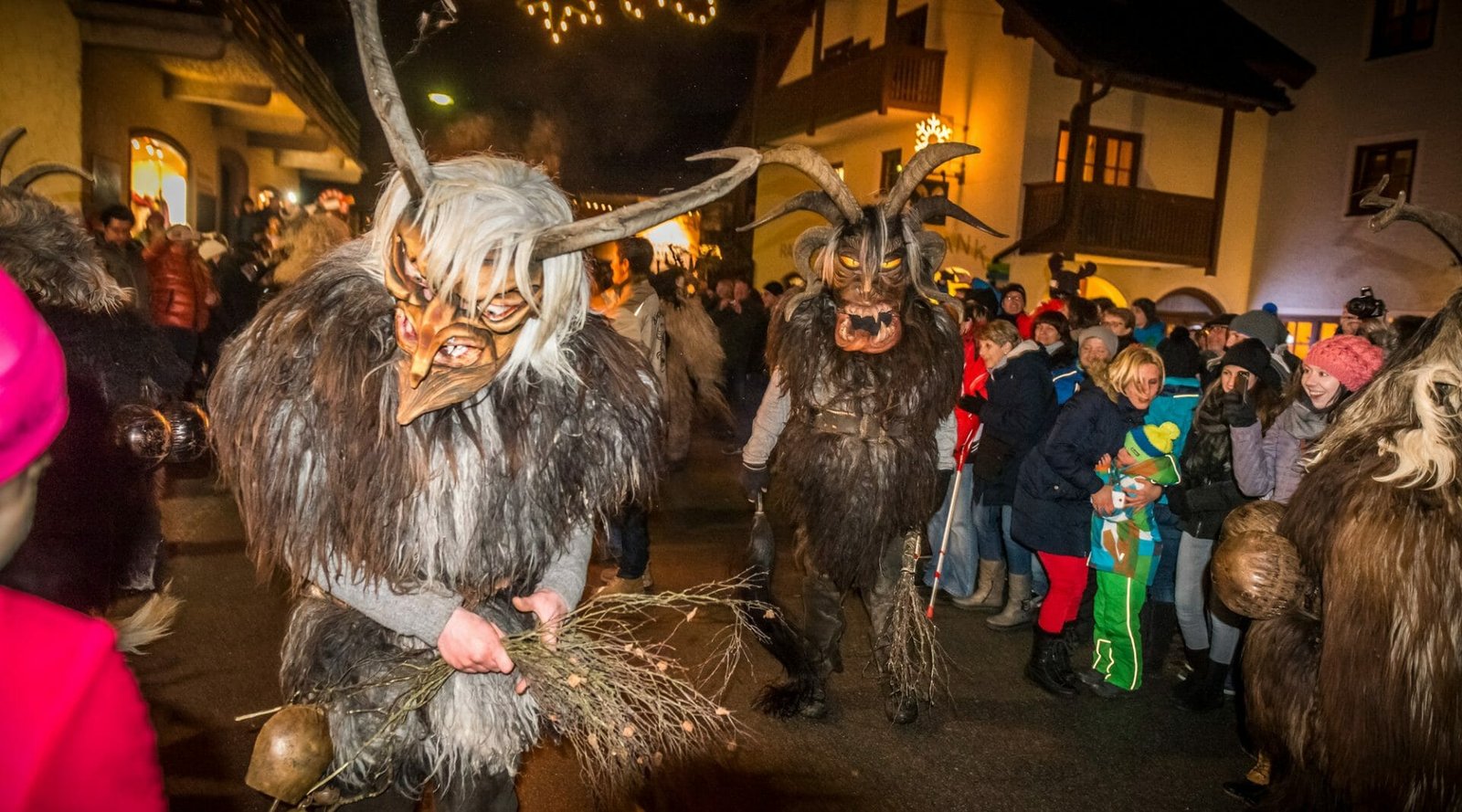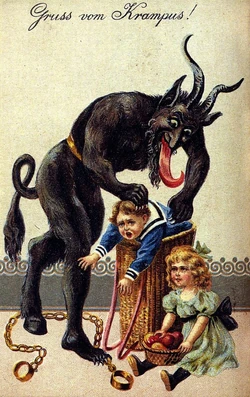Folklore Unwrapped
Seasonal: The History of Krampus
By Robert Matsumura, Active Media
Traditionally, Christmas evokes images of Santa Claus, twinkling lights, stuffed stockings over the hearth and gifts beneath the tree. In the heart of the Alps, however, another figure lurks in the shadows of the holiday season, a horned and hairy creature that has for centuries been a part of Central European folklore — Krampus.

The Origins of Krampus
The origins of Krampus reach back to pre-Christian Alpine traditions. The name Krampus derives from the German word krampen, meaning “claw.” Rooted in ancient Norse and Germanic pagan customs, specifically those centered around winter solstice celebrations, Krampus was a horned beast with shaggy fur and a devilish appearance who roamed the land during the dark of winter. With the onset of Christianity however, devilish figures were frowned upon, so rather than eliminating Krampus altogether, he was reinterpreted as a cautionary figure who would scare children into proper behavior, working alongside the benevolent St. Nicholas.
Krampus and St. Nicholas: An Unlikely Partnership
For every well-behaved child a troublemaker existed, and this was where Krampus came in. While St. Nicholas rewarded the good children with presents and treats, Krampus dealt with the naughty ones with spankings and even hauling them away to the underworld in some cases. The duality of St. Nicholas and Krampus mirrored the Christian concept of heaven and hell — good and evil — where virtue is rewarded and vice
is punished.

Krampusnacht: A Night of Terror
On the eve of St. Nicholas Day, December 5, Krampusnacht — “Krampus Night” is celebrated across Central Europe. On this night, men don terrifying costumes and roam the streets as Krampus, scaring children (and sometimes adults) in Krampus parades known as Krampuslauf. These days, Krampus has expanded beyond his traditional Alpine roots. Global media, films and TV shows have embraced Krampus, and in the United States, Krampus has become something of a cult figure. Krampus-themed events, parties and even horror films have reintroduced him to a new generation. Much of the appeal of Krampus lies in his contrast to the commercialized image of Christmas in modern culture. Krampus represents the balance between light and dark, joy and fear — a reminder that the holiday season, while full of cheer, also contains an element of mystery and unease.

Why Krampus Matters
Today Krampus continues to be popular around the world, demonstrating the power of folklore and its ability to evolve over time. Whether you find him fascinating, frightful or both, there’s no denying that Krampus has carved out a unique place in holiday history — one where the naughty children had better beware!

I’m really impressed along with your writing skills as smartly as with the format in your weblog. Is that this a paid subject or did you modify it yourself? Either way keep up the nice quality writing, it is uncommon to peer a great weblog like this one nowadays!
**mindvault**
mindvault is a premium cognitive support formula created for adults 45+. It’s thoughtfully designed to help maintain clear thinking
**breathe**
breathe is a plant-powered tincture crafted to promote lung performance and enhance your breathing quality.
https://t.me/s/iGaming_live/4621
https://t.me/s/Beefcasino_rus/59
https://t.me/Top_BestCasino/130
That’s so cool! Music creation used to feel so complicated, but platforms like Sprunki Mod are changing that. It’s awesome anyone can make beats now, especially with that street art vibe! ✨
https://t.me/officials_pokerdom/3750
Descobri abcbet1br e tô achando bem interessante! Variedade de jogos e umas promoções que chamam a atenção. Alguém mais testando por aqui? Deixem suas impressões! abcbet1br
Yo, 33dgame is legit! Been playing here for weeks and haven’t had any issues. Definitely worth a look if you’re into this stuff 33dgame
https://t.me/s/be_1win/95
Your point of view caught my eye and was very interesting. Thanks. I have a question for you. https://www.binance.com/register?ref=IHJUI7TF
Trying to remember my 50jililogin. Swear I wrote it down somewhere. Oh well, password reset here I come!
Your point of view caught my eye and was very interesting. Thanks. I have a question for you.
Es bietet eine große Auswahl an Spielen, darunter Slots, Tischspiele
und Leben-Dealer-Optionen. 888 Casino hat eine
große Auswahl an Spielautomaten, Tischspielen und Leben-Dealer-Optionen. Es bietet
spannende Spiele, große Boni und eine sichere Plattform.
Im Vergleich zu anderen Die besten Online Casinos bietet 888casino durchweg
großzügigere und leichter zugängliche Boni.
Die Spielauswahl ist einfach zu navigieren, so dass Sie schnell Ihre bevorzugten Spiele finden können. Die Plattform bietet erstklassige Spiele von bekannten Softwareanbietern, die
ein qualitativ hochwertiges Gameplay und fesselnde Erlebnisse garantieren. 888casino zeichnet sich durch
seine Spielauswahl, Sicherheit und seinen guten Ruf aus.
VIP-Mitglieder genießen einen persönlichen Service, höhere Auszahlungslimits
und spezielle Angebote wie 888 Casino Freispiele für bestehende Kunden. Es
wurde 1997 gegründet und bietet eine breite
Palette von Spieloptionen, darunter Slots, Tischspiele und Live-Dealer-Spiele.
888casino ist eines der führenden Online-Casinos, das für seine Vielfalt
an Spielen und seine sichere, benutzerfreundliche Plattform bekannt ist.
Werfen Sie mit uns einen Blick hinter die Kulissen der Glücksspielangebote.
An den drei Pokertischen werden die vier Varianten Texas Holdem,
Omaha Poker, Seven Card Stud sowie Ultimate Texas Holdem gespielt.
Das Entertainmentcenter bietet ausser einem reichhaltigen Spielangebot auch Restaurants und Bars an. Spielerinnen und Spieler können sich ihr Guthaben über den direkten Kontakt
mit dem Grand Casino Basel bis zum 30. Seit 1824 wird das Stadtcasino Basel von der gemeinnützigen Casino-Gesellschaft Basel betrieben.
Glücksspiel kann süchtig machen, bitte spiele verantwortungsbewusst.
In der Schweiz beträgt das Mindestalter für Glücksspiele mit Echtgeld im Casino 18 Jahre.
Umgeben von 25 Live Dealer Tischen und mehr als
300 Automatenspiele kommt schnell eine gute und spannende Casinoatmosphäre
auf. Einsätze für die Casinospiele sind schon ab CHF 1 möglich.
Ich habe die Spielbank Baden selber geprüft und einige Runden in der Schweizer Spielbank gespielt.
References:
https://online-spielhallen.de/verde-casino-auszahlungen-schnell-sicher-einfach/
Wenn Sie bei Vulkan Blackjack online spielen, können Sie wählen, ob Sie auf Ihrem PC oder Ihrem
mobilen Gerät spielen möchten. Auf diese Weise lernen Sie die
grundlegende Strategie und verbessern Ihre Chancen auf echte Geldgewinne, wenn Sie
um Echtgeld spielen. Das können Sie tun,
indem Sie gratis online Blackjack spielen oder einen Simulator verwenden. Kostenlos Blackjack spielen ist auch
eine gute Option, wenn Sie sich einfach nur entspannen und etwas Spaß haben wollen. Blackjack online free spielen ist eine gute Möglichkeit, das
Spiel zu lernen oder neue Strategien auszuprobieren, ohne Geld zu riskieren. Wenn Sie ein Spiel mit einer Auszahlung von 6 zu 5 spielen und 10 Euro setzen und einen Blackjack erhalten, gewinnen Sie
nur 12 Euro.
Wenn Sie nicht nur von Ihrem Computer zuhause in unserem Online Casino spielen wollen, haben wir
gute Nachrichten. In den meisten Fällen können Sie Ihre Anliegen hier selbst lösen und
wieder sorgenfrei in unserem Casino spielen. Und Ihre dritte Einzahlung wird mit 120% bis zu 500
Euro plus 50 Freispielen für Book of Tribes belohnt. Bei der zweiten Einzahlung bekommen Sie dann weitere 150% bis zu 500
Euro an Bonusgeld sowie 30 Freispiele für Book of Fallen. Alle Sofortspiele aus
dieser Kategorie können auch ohne den Einsatz von Echtgeld ausprobiert werden.
References:
https://online-spielhallen.de/monro-casino-test-erfahrungen-fur-deutsche-spieler/
Your article helped me a lot, is there any more related content? Thanks! https://www.binance.info/register?ref=IHJUI7TF
Swipes, taps, spins — all smooth, no freezing, no lag.
No stripped-down version — it’s the full casino in your pocket.
No clunky downloads or weird app store workarounds — just
open your browser, log in, and play. Sky Crown Casino runs flawlessly on mobile,
whether you’re using Android, iOS, or something in between. Sky Crown online partners with
studios like Evolution, Ezugi, and Lucky Streak — big names known for quality, fairness, and serious variety.
The whole platform’s built for nonstop action — no endless scrolling, just straight to what you want.
SkyCrown has a vast array of deposit and withdrawal options.
To claim this, deposits must be over $30, and
you’ll need to wager 40X. To get full wagering, you’ll need
to bet 30X the amount you won in your free spins. Players can get 30 free spins without adding any money.
Let’s look at their promotional offers. Large providers like
Winfinity, Atmosfera, and Platipuslive are available.
References:
https://blackcoin.co/10-minimum-deposit-casino-bonuses-in-australia-2025-guide/
In other words, you can use your Smartphone, tablet, desktop computer, or laptop to access special
casino bonuses. The following is the list of casinos that offer this kind of deal.
Therefore, players may take advantage of a lot of free spins.
Our casino list is updated every day to make sure the offers are current.
The more you play, the more perks you unlock, with free spins and
bonus credits frequently given to frequent players. These codes might be exclusive to certain players or promotions,
so always look out for them when registering at a new casino.
Ignition Casino’s no deposit bonus is a personalized offer, which means
that the reward varies for each player. Ignition Casino, 2016 and licensed in Curacao, is one of the leading online casinos in the
Australian market. This bonus offers a chance to
try out the platform’s various slots, including high RTP games,
and start winning immediately. This bonus gives players the chance to explore the casino’s extensive game library, which includes
over 300 slots from popular developers like Rival and Arrow’s Edge.
Being a top player in the industry allows us to engage in direct
negotiations with online casinos for exclusive no deposit bonuses not found anywhere else.
Yes, you can gamble with real money and play thousands of
games at Australian online casinos. If possible, be sure to take advantage of cashback offers and other
bonuses at Australian online casinos. We’ve configured our database to help
players everywhere find the online gambling
houses that offer no-deposit bonuses with the highest cashouts
and the friendliest terms to players.
References:
https://blackcoin.co/a-world-of-play-awaits-syndicate-casino/
If you are using credit/debit cards, you need to deposit $15, but those who
use Neosurf vouchers can start with A$10. Moreover, Aussies pick this
gambling site for a broad range of popular banking options that they can use
to deposit and withdraw money. This is the fastest way to reach the support
service (the average response time is 30 seconds to one minute).
The live chat feature is available on the official website at
the bottom of the page. In addition, the KingBilly gambling site offers
the safest payment methods, which means that you can expect fast and
secure transactions. Moreover, you can protect your account by setting the
2FA feature.
Australian players benefit from native English-speaking
representatives familiar with local banking systems and regulatory requirements.
The support team undergoes regular training on platform features, payment processes, and responsible gaming protocols to ensure
accurate assistance. King Billy Casino maintains comprehensive
support infrastructure addressing player inquiries through multiple communication channels.
The transparent tier progression system clearly displays
requirements and benefits, allowing players to track advancement
toward their next level.
References:
https://blackcoin.co/aus96-casino-in-depth-review/
Each game is designed as a standalone project to showcase my programming
skills, focusing on clean code, modularity, and functionality.
We read every piece of feedback, and take your input very
seriously. We encourage users to open issues as and where they find them.
Repacks are highly compressed game downloads, designed for people with slow/limited
internet bandwidth. And now, on with the game-hacking goodness!
OpenSpiel is a collection of environments and algorithms for research in general reinforcement
learning and search/planning in games. Play your favorite games in a borderless window;
no more time consuming alt-tabs.
References:
https://blackcoin.co/mystake-casino/
Players searching for a new casino will often try out
multiple different sites, so to keep users from jumping around, their loyalty programs are often more
generous, in-depth, and enhanced through modern technologies.
For new casinos, these are even more important than for established ones.
More specifically, integrations with VR/AR features can suggest the
casino is investing in long-term player engagement and cutting-edge technology, so look out for that.
We’ve visited and vetted numerous sites and listed all the best ones here for you.
Gambling can be addictive; if you’re suffering from gambling-related harms, please call GAMBLER.
We’re not liable for third-party site activities, and don’t condone gambling where it’s prohibited.
References:
https://blackcoin.co/how-online-casino-vip-programs-work/
Settle a dinner table debate, or practice a new
language. In July 2024, the American Bar Association (ABA) issued its first formal ethics opinion on attorneys
using generative AI. On November 29, Rosário revealed that the bill had been entirely
written by ChatGPT, and that he had presented it
to the rest of the council without making any changes
or disclosing the chatbot’s involvement. In Mata v. Avianca, Inc., a personal injury
lawsuit filed in May 2023, the plaintiff’s attorneys used ChatGPT to
generate a legal motion. In November 2025, OpenAI acknowledged that there have been “instances where our 4o model fell short in recognizing signs of delusion or emotional dependency”,
and reported that it is working to improve safety.
A 2025 Sentio University survey of 499 LLM users with self-reported
mental health conditions found that 96.2% use ChatGPT, with
48.7% using it specifically for mental health support or
therapy-related purposes.
Rivaling patient care in some of the finest
hospitals, AirMed air ambulances are equipped for virtually
every critical care scenario. AirMed offers unparalleled medical care and bedside-to-bedside transportation on a worldwide basis and boasts the most experienced air medical crews in the industry.
AirMed International is the leading air ambulance and medical
transport company in the United States, with 25,000 total missions and counting.
There are a lot of misperceptions about the cost
of air medical transport. Air Methods has a talented workforce of over 4,500 team members, which includes the best in the air medical industry.
References:
https://blackcoin.co/cashman-casino-slots-games-comprehensive-guide/
Super happy with 88clbapp! The app runs smoothly on my phone, and I’ve already won some decent money. Highly recommend it!
online casino mit paypal
References:
makeshare.org
paypal casinos for usa players
References:
http://www.dycarbon.co.kr/bbs/board.php?bo_table=free&wr_id=564552
online pokies australia paypal
References:
https://cloudwapi.site/hungsupple9863
best online casino usa paypal
References:
https://martdaarad.com/profile/elyseg50820864
paypal casino sites
References:
https://jobsinodisha.org/companies/15-best-online-casinos-australia-trusted-sites-for-real-money/
australian online casinos that accept paypal
References:
https://www.likelegal.nl/companies/online-casinos-australia-best-aussie-casino-sites-of-2025/